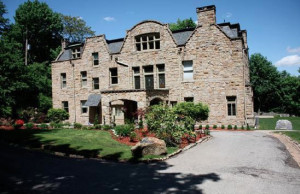Gilded Age magnates were squires of Squirrel Hill
by Patricio Chile
A simple mansion was not enough for Andrew Mellon.
Upon buying steel baron George Laughlin’s Squirrel Hill estate in 1917, the banking magnate promptly added a bowling alley, tennis courts and an indoor swimming pool; one of the first in Western Pennsylvania. The pool room even featured an arched Guastavino ceiling, a style of interlocking tiles popular in early 20th century New York architecture.
Less than a mile away, Andrew’s brother Richard built an even bigger home. Richard Beatty Mellon’s mansion, built in 1910, sat on 11 acres and boasted 65 bedrooms, two large flower gardens, a garage and a carriage house.
The extravagance of the Mellons may never be seen again. Author and historian Melanie Linn Gutowski says the combination of cheap building and energy costs with the growth of the steel and oil industries led to Pittsburgh’s Gilded Age of lavish mansions, particularly along a Fifth Avenue stretch known as “Millionaire’s Row.”
Other mansions in the area included industrialist Charles Marshall’s home at the corner of Fifth and Shady Avenues, now the Pittsburgh Center for the Arts, Ben Elm, a Forbes Avenue home owned by a nephew of Andrew and Richard, and Gulf Oil Corporation founder William Larimer Mellon. One of the most infamous houses in the area was called Lyndhurst. Built for mining and railroad baron William Thaw in 1887, part of the Gothic Revival home was later sold to raise funds for Thaw’s son Harry who was arrested for murdering prominent architect Stanford White in 1906. Lyndhurst, as well as most of the other mansions, was demolished by the mid-20th century.
“It’s the kind of wealth that can’t happen anymore,” Gutowski says. “A lot of those houses didn’t even stand for 50 years before they were torn down.”
Andrew Mellon’s estate is one of the few to survive the Great Depression. Donated to the Pennsylvania College for Women (now Chatham University) in 1941, the imposing brick mansion is tucked among leafy trees on Woodland Road, a narrow winding street bridging Squirrel Hill and Shadyside. A glimpse behind the house reveals the mansion’s features: elegant bay windows, large stone balconies and rolling lawns.
And although Richard’s house was torn down in 1941, his estate is now Mellon Park, the rolling grassy stretch that runs along Fifth Avenue between Shady and Penn Avenues. The estate’s Walled Garden, a greenspace wrapped in tapestry brick walls, has been restored and is open to the public, as are its stone walkways, intricate fountains and iron gates designed by renowned blacksmith Samuel Yellin.
It was designers like Yellin and architects like Frank Alden who added the truly remarkable touches to homes in the area, Gutowski says. Regardless, the Mellon family set the precedent for many of the “nouveau-riche” families that later formed Millionaire’s Row.
“They were the tastemakers,” she says.
